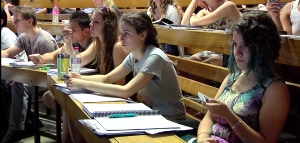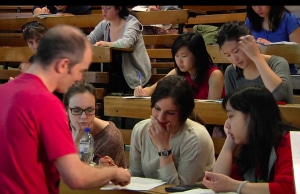Week 4 // Open Door is a university-wide event designed to enable people to see how others teach and to observe how innovative approaches work in practice. Across campus, around 60 lectures have been “opened” by lecturers from a wide range of disciplines for others to attend and observe. Observers will be sitting with the students and can watch how they react, learn and engage.
Observing others lecture is a simple and time-efficient way to refresh your teaching ideas and to put yourself back in the place of the learner. Our hope is that participants will enjoy the experience and learn so much that they’ll regularly attend other classes as well as asking colleagues to come to theirs.
My experience of peer observation

I lectured in the UK for about 12 years before coming to Australia, In the UK, I thought my classes of 80 students were large. However, when I came to Sydney as Director of First Year Chemistry in 2006, my classes numbered over 2000! I realised that my style of lecturing would need to be re-thought to be effective in these truly large classes. In my first few weeks, I sat at the back of 20 first year chemistry lectures: some were great, others were less effective. Sitting in the back row, it was clear that some students were struggling with the concepts early in the lecture and then becoming disengaged. Even with the most engaging lecturers, many were losing concentration half way through.

I learnt some simple tricks from the best lecturers I saw, including using colourful demonstrations to re-focus the class half way through and setting problems for the students to solve in groups at key points. I learnt almost as much in the less effective classes. In particular, I realised that when I was a student I had been one of those ones that sat at the front who listened and avidly took notes. I succeeded in “talk and chalk” lectures but many of our students don’t. The differences between the effective and disengaging lectures were small and not down to the personality of the lecturer. The most important element was the lecturer’s enthusiasm. The best lectures were those in which the students were active: solving problems, discussing issues, writing their own summaries etc. Small changes that I could introduce into my own classes.
Observing others teach and asking trusted colleagues for feedback on our own teaching is a really effective way of keeping your teaching up to date and effective. I hope you will have time in “Week 4 // Open Door” to give it a go. If not, perhaps just ask a colleague if you can sit in on their class on another day? The University is a learning community and we have some wonderful teachers.





